
LinkedIn ads are one of the most important and effective tools in a B2B marketer’s toolbox.
However, without a proper targeting strategy, success likely won’t come.
This article outlines essential strategies to help you reach your ideal audience and help your LinkedIn ad campaigns succeed.
First, let’s dive into what makes LinkedIn ads different.
How LinkedIn Differs From Other Social Media Platforms
While other platforms, such as Facebook, tend to focus on what their members do in their personal lives, LinkedIn is the opposite. The focus is on what members do in the professional world.
LinkedIn’s targeting facets reflect this, offering more in-depth options to target individuals based on their profession and even their level of seniority.
While there are certainly some interesting use cases for LinkedIn ads in a B2C environment, they are ideal for B2B advertising.
Key LinkedIn Ads Targeting Practices
Here are some of the most important ad targeting practices when choosing your LinkedIn audience.
Audience Size
As you use the options below to build your target audience, you may be wondering: “How big should my LinkedIn ads audience be?”
The minimum audience size for launching a campaign is 300 members. However, in its help page on the topic, LinkedIn suggests a minimum of 300,000 for sponsored content and between 60,000 and 400,000 for text ads.
In CommonMind’s experience, we find much smaller audience sizes can be successful. If you serve a niche market, there simply may not be 300,000 LinkedIn members within that niche.
As a general rule, we consider 30,000 – 100,000 members to be the sweet spot for audience size.
Location
LinkedIn ad targeting always starts with choosing a location. The location field is also the only mandatory field.
You have two approaches here:
- Broad targeting (states or country-wide)
- Narrow targeting (specific cities or metropolitan areas)
Choose your target location based on the geographic region that your company services. If the users you want to reach are primarily in North America, you will probably want to choose “United States” and “Canada.”
If you service an international audience, you’ll want to set up separate campaigns for each region, e.g. A campaign for North America, another for Europe, Middle-East and Africa (EMEA), and a third for Asia Pacific (APAC). If your audience size is big enough, or if you’re able to advertise in country-specific languages, further subdivision by country can prove helpful.
Performance is likely to vary depending on the country. We’ve split test ads in North America where the winner was the loser when running the same ads in EMEA or APAC.
On the flip side, if your company is more regional, restrict your geographical settings to the states or metropolitan areas that are most pertinent to your business.
LinkedIn also gives you the options of:
- Recent or permanent location: People who recently visited or permanently live or work in the selected location(s).
- Permanent location: People who permanently live or work in the selected location(s).
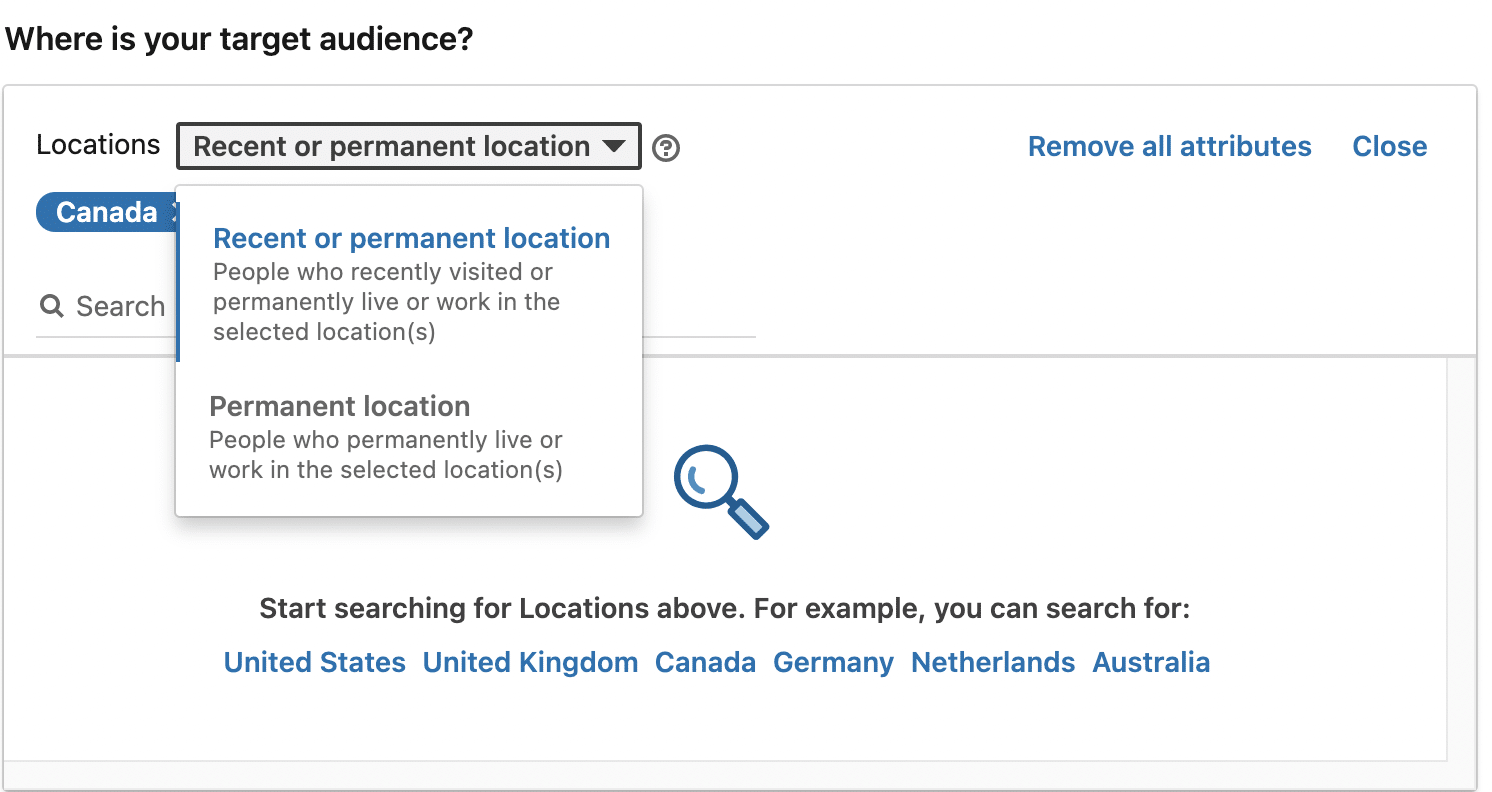
“Permanent location” often makes the most sense, but there are cases where you’d want to reach someone recently visiting a location rather than simply those permanently living there. For example, an event supplies company in San Francisco may want to reach event planners traveling to (recently arriving in) San Francisco, not just people who permanently live there.
Use the Powerful Company Targeting Options to Your Advantage
Of the company targeting options, there are three that we focus on the most:
- Company size
- Industry
- Company names
Company Size
Company size options on LinkedIn are split into size buckets ranging from single-person companies to companies with over 10,000 employees:
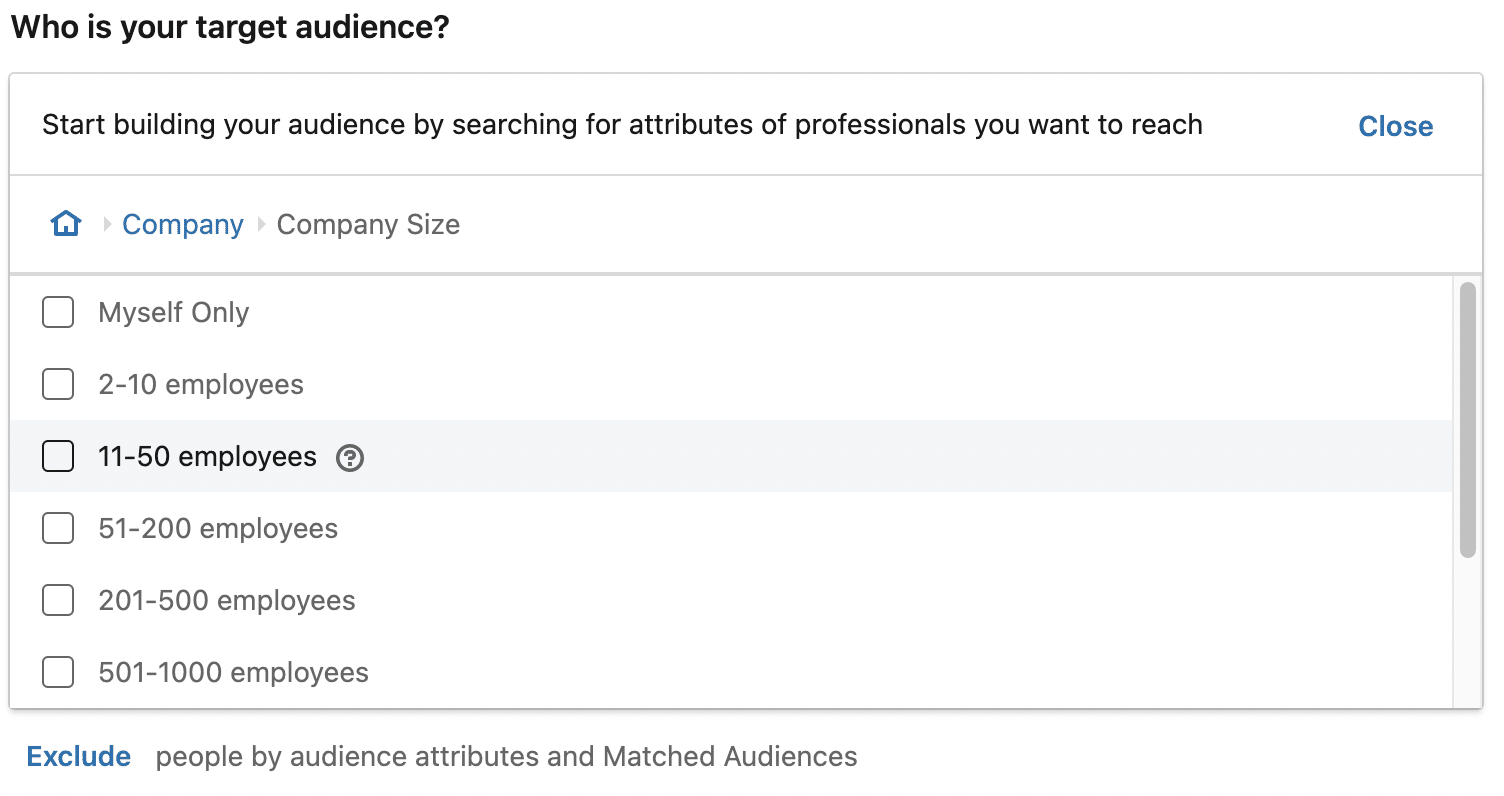
The most common use of size buckets for LinkedIn ad targeting is to include only company sizes that represent your ideal audience.
Can you target by revenue size on LinkedIn?
As noted above, LinkedIn’s “company size” facet is based on employee count. Some advertisers would prefer to target by revenue size. If you are working with a LinkedIn rep, they may help you with targeting by revenue, but the option of targeting by revenue isn’t available in the advertising interface itself.
Industry
Company industry, while a straightforward field, can be tough. The industry options given to you by LinkedIn are broad, which can make targeting a challenge.
The problem here is that many companies are uncertain which industry they fall into when creating a company LinkedIn page. There’s a chance that companies in your target audience might fit into more than one of the default categories.
If your target audience fits into one of the industry options, choose that industry for ad targeting. If not, then you can go without using the industry option.
Company Names
In each LinkedIn ad campaign, you can target up to 200 specific companies.
“But wouldn’t it be a tedious process to type out 200 different company names?”
It’s true that manually typing out company names isn’t an ideal process, but there’s value here.
You maximize your match rate by starting to type out specific company names and allowing LinkedIn to fill them in. You also ensure that the companies you want to target are able to be matched to specific LinkedIn members.
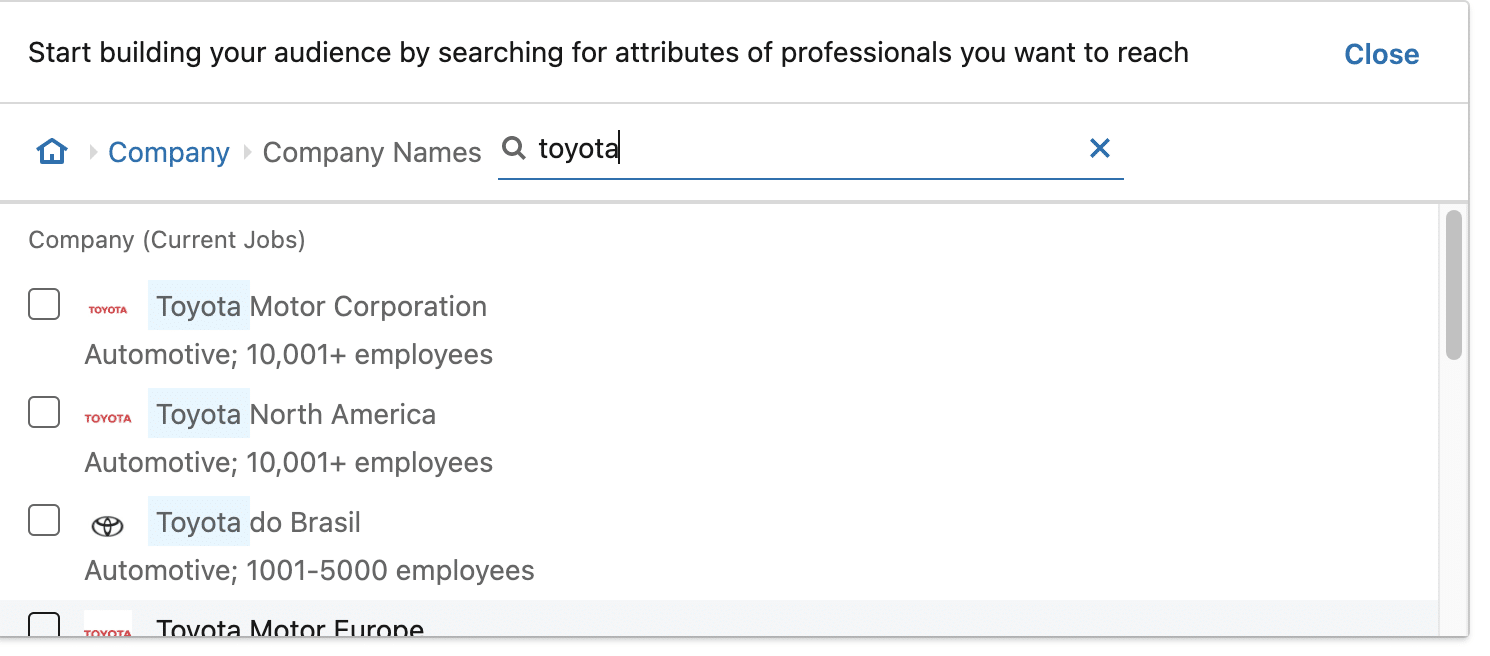
Uploading a Company List for ABM Targeting
If you’ve already researched a list of companies you want to target, you can also upload a company list to LinkedIn.
Start by clicking on “audiences.” On the right, you should then see a tab called “List upload”:
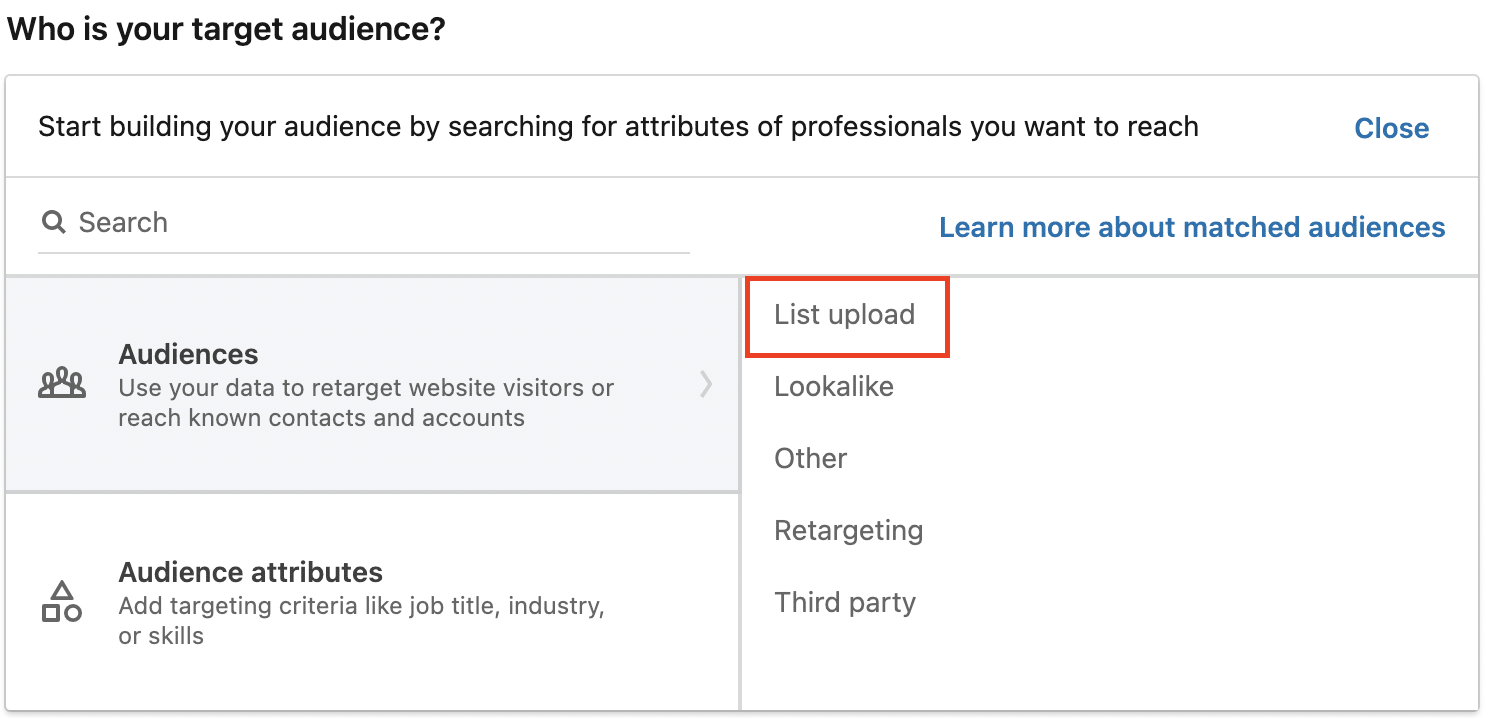
Once in the list upload menu, click on “Company list” and then “Upload a list” in the right-hand corner:
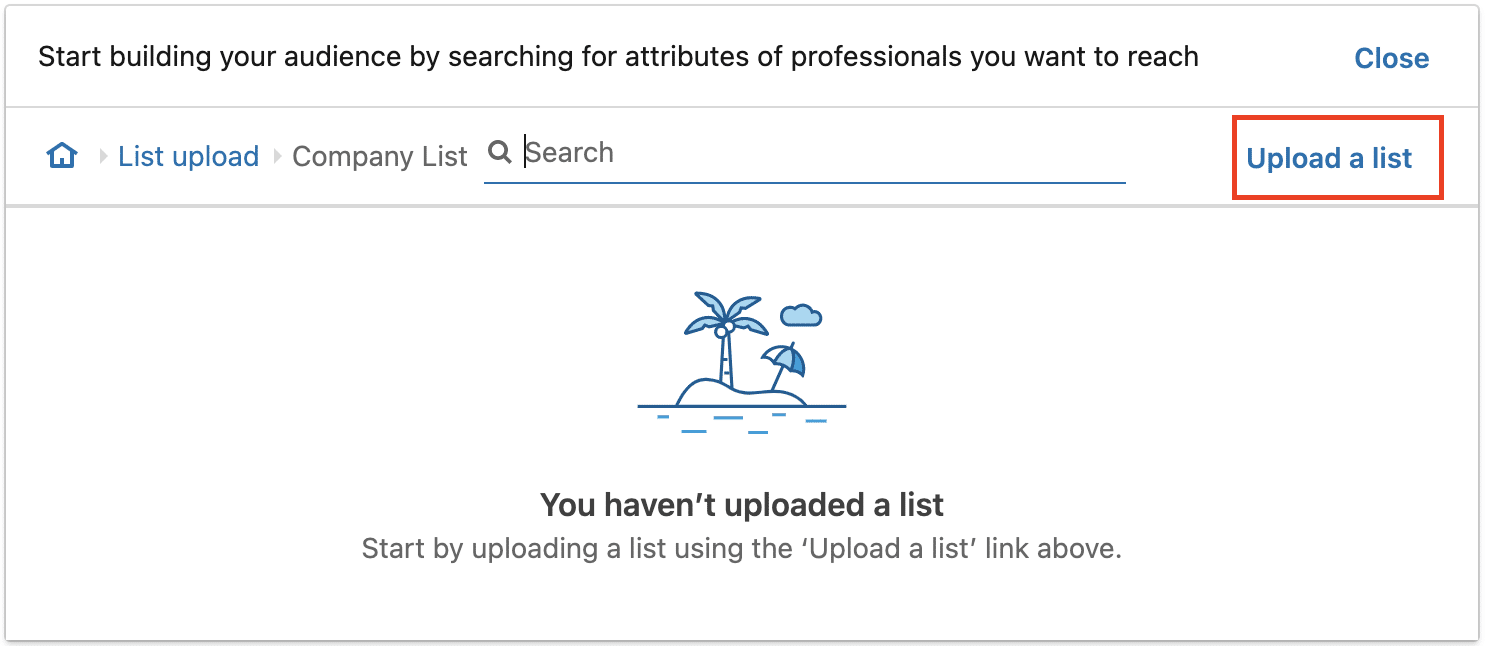
This step allows you to upload a predetermined list of companies you wish to target without having to type out each company name individually. Uploading a list also helps when your company list is more extensive since you can’t manually type out more than 200 company names in one campaign.
The minimum audience size on LinkedIn ads is 300 users. Therefore, when specifying your list of companies, consider whether there will likely be at least 300 users who work at those companies and meet your other targeting criteria.
Targeting Individuals
LinkedIn offers some additional targeting options beyond targeting companies.
When appropriately used, the individual targeting facets can be used to effectively reach your target audience. Some of these targeting options include:
- Job function
- Job title
- Seniority
- Education
- Skills
- Groups
Job Function
There are a nearly infinite number of job titles. For example, one company’s “VP of Sales” may serve the same role as another company’s “Director of Business Development.” If you can identify a short list of job titles that you want to reach, great! Use the job titles facet. Otherwise, LinkedIn’s option to narrow by job function is your best bet.
The job functions available for targeting are:
| Accounting | Legal |
| Administrative | Marketing |
| Arts and Design | Media and Communication |
| Business Development | Military and Protective Services |
| Community and Social Services | Operations |
| Consulting | Product Management |
| Education | Program and Project Management |
| Engineering | Purchasing |
| Entrepreneurship | Quality Assurance |
| Finance | Real Estate |
| Healthcare Services | Research |
| Human Resources | Sales |
| Information Technology | Support |
LinkedIn has an algorithm that takes the job titles indicated by members and translates them into LinkedIn’s version of that job title. Job Title
When targeting by job title, it’s important not to limit yourself to only a few job titles.
To help with this, LinkedIn will suggest related titles to the ones you input. With this, you can choose additional titles that match your target audience but didn’t immediately come to mind.
Seniority
Job seniority describes a LinkedIn member’s role within a company and how much decision-making power they may (or may not) have.
Combining this field with the job function field can yield positive results. Not only will you be targeting people in the correct department, but you also ensure that you’re targeting people who have enough seniority within their organization to make a decision based on your ads.
The job seniorities available for targeting are:
| Unpaid | Director |
| Training | VP |
| Entry | CXO |
| Senior | Owner |
| Manager | Partner |
As you may imagine, many advertisers want to reach the most influential decision-makers within a company, and the number of individuals in those roles is small. In other words, there is a high demand to reach these users and a low supply of users to reach. Thus, expect to pay a premium if you limit your campaign to higher-level job seniorities.
Education
Targeting by member education has three different fields:
- Member schools – The learning institutions where members have attended or studied
- Fields of study – Any area of study populated based on member degrees
- Degrees – Specific accomplishment granted from the learning institution
While using these facets can yield positive results, it’s crucial not to lean too heavily on them as they can negatively limit your audience size. Member school, for example, is a field sometimes left blank by LinkedIn members since it isn’t a requirement.
Skills
Skills are specific keywords indicated by members throughout their profiles, including within their profile description and in their listed skills section. LinkedIn also has an algorithm to identify particular skills based on job titles and descriptions.
Targeting by member skills is yet another method of honing in on a relevant audience, and can be especially powerful when used in combination with job function and seniority. It can also be used as an alternative to job titles since certain skills could span a broader range of job titles.
Groups
This field targets audiences based on the LinkedIn discussion groups that they elected to belong to. The groups field can be used to target either professional or personal interests.
As an example, if your target audience is in the marketing space, you could target members of the group Media & Marketing Professionals Worldwide, which boasts a membership of over 900,000 people.
Reach Prospects You Know With Contact Targeting
Similar to uploading a list of companies, you can also conveniently upload a pre-existing list of individual contacts, whether from an email list or a CRM platform, such as HubSpot.
Follow the same steps as a company list upload, but instead of clicking on “Company list,” you’ll click on “Contact list”:
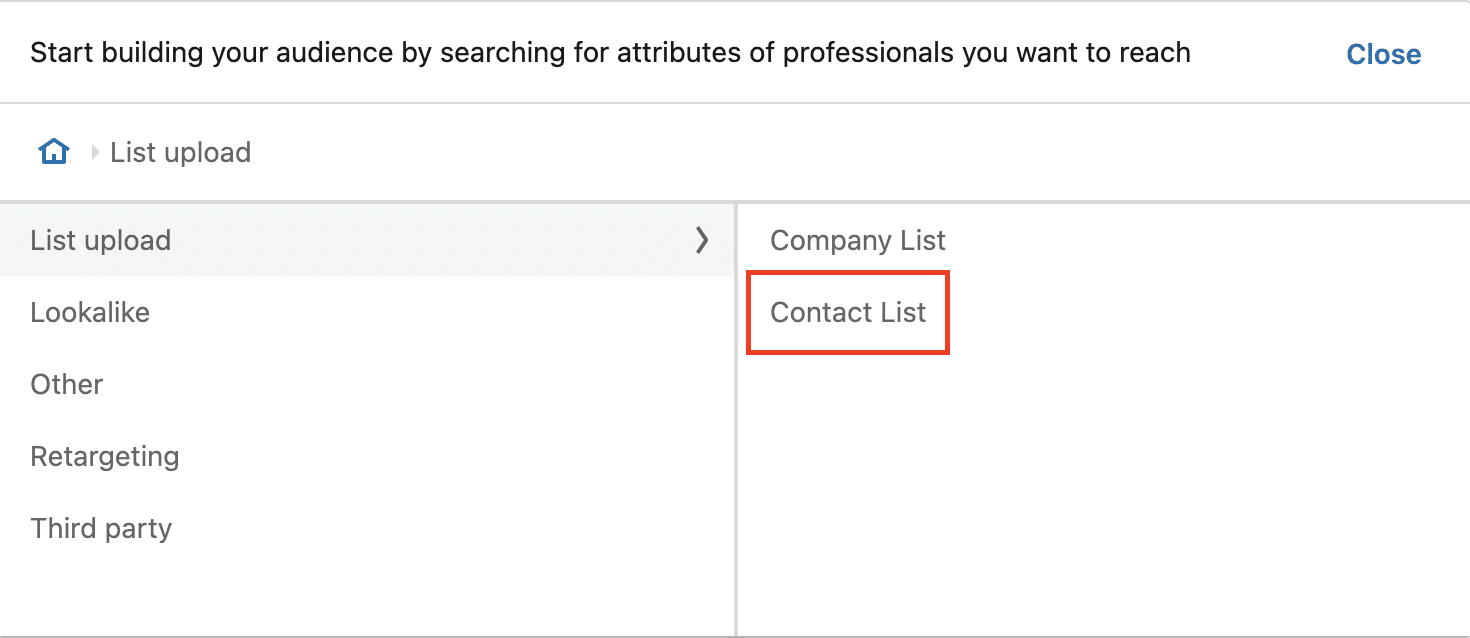
From there, you’ll again click on “Upload list” in the top right corner.
For contact lists, LinkedIn recommends uploading at least 10,000 contacts to maximize your chances of success. Similar to company lists, there’s a maximum allowance of 300,000 contacts.
Avoid Limiting Your Scale Too Much
Honing in on your target audience is essential and ensures that you end up with quality leads.
On the other hand, hyper-targeting can have adverse effects on your ad targeting efforts, depending on your goals.
For your initial campaigns, LinkedIn recommends starting with an audience of at least 50,000. Starting bigger ensures that you’ll be casting a wide enough net, and you won’t be missing out on potentially promising leads.
That being said, we’ve also seen success with smaller audiences. The downsides of small audiences (under 20,000 users) are lower volumes of clicks and potentially higher CPCs because you’re competing to reach a smaller group. On the other hand, when the audience members do click, they may be much more likely to convert since they meet your target criteria so perfectly.
A/B Test and Optimize
Adapting is key throughout all digital marketing fields, and LinkedIn ads are no exception.
Running A/B tests can help you determine the right changes to make to your ad campaigns to help them succeed. Start by creating two identical ad campaigns. From there, test two different audiences, e.g. one built around Job Titles and another built around Job Function + Skills.
Keep in mind that it’s recommended to allow these A/B tests to run for at least two weeks or 200 clicks per campaign. This should give you the most accurate data moving forward. You will also want to keep an accurate record of your A/B tests over time to gain further insight into your target audience over time.
LinkedIn Ads are a Powerful Tool For Reaching Your Target Audience
LinkedIn is undoubtedly unique when compared to other social media platforms. With many individuals and companies creating LinkedIn pages for professional purposes, it’s the perfect environment for effective B2B advertising.
The ad targeting facets that LinkedIn offers are numerous and powerful. With these tips, you can effectively reach your target audience and maximize the success of your LinkedIn ad campaigns.
For a quick reference to the concepts in this blog post, we’ve summarized everything in this infographic.
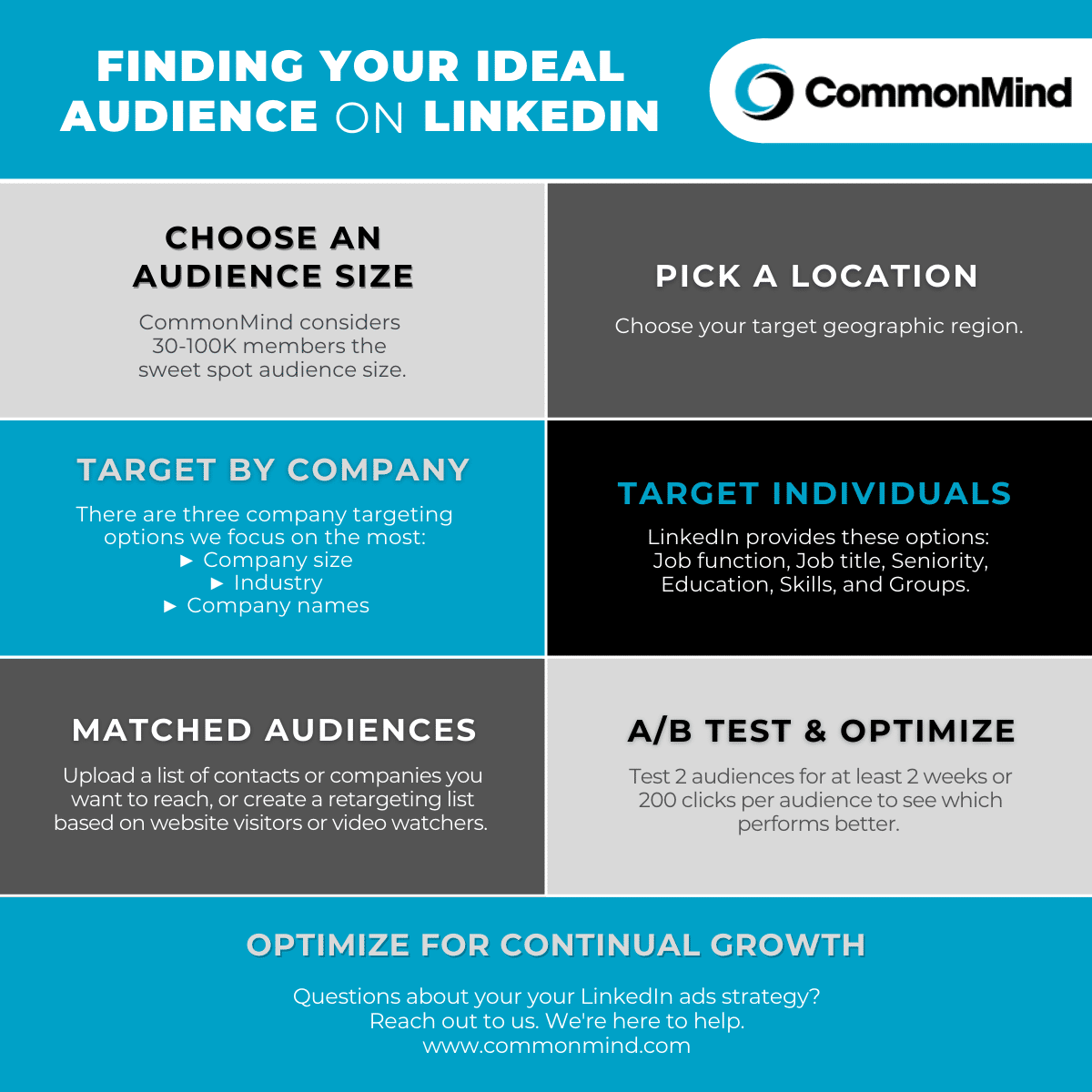
CommonMind Can Help With Your LinkedIn Ads Strategy
Keeping up with social media ads, along with the latest trends, can be tricky. When you work with CommonMind, we handle your LinkedIn ads strategy for you, helping you meet your goals and optimize for continual growth.
Reach out to us. We’re here to help.
Share this
You May Also Like
These Related Stories

What Kind of Offers Should I Promote on LinkedIn?
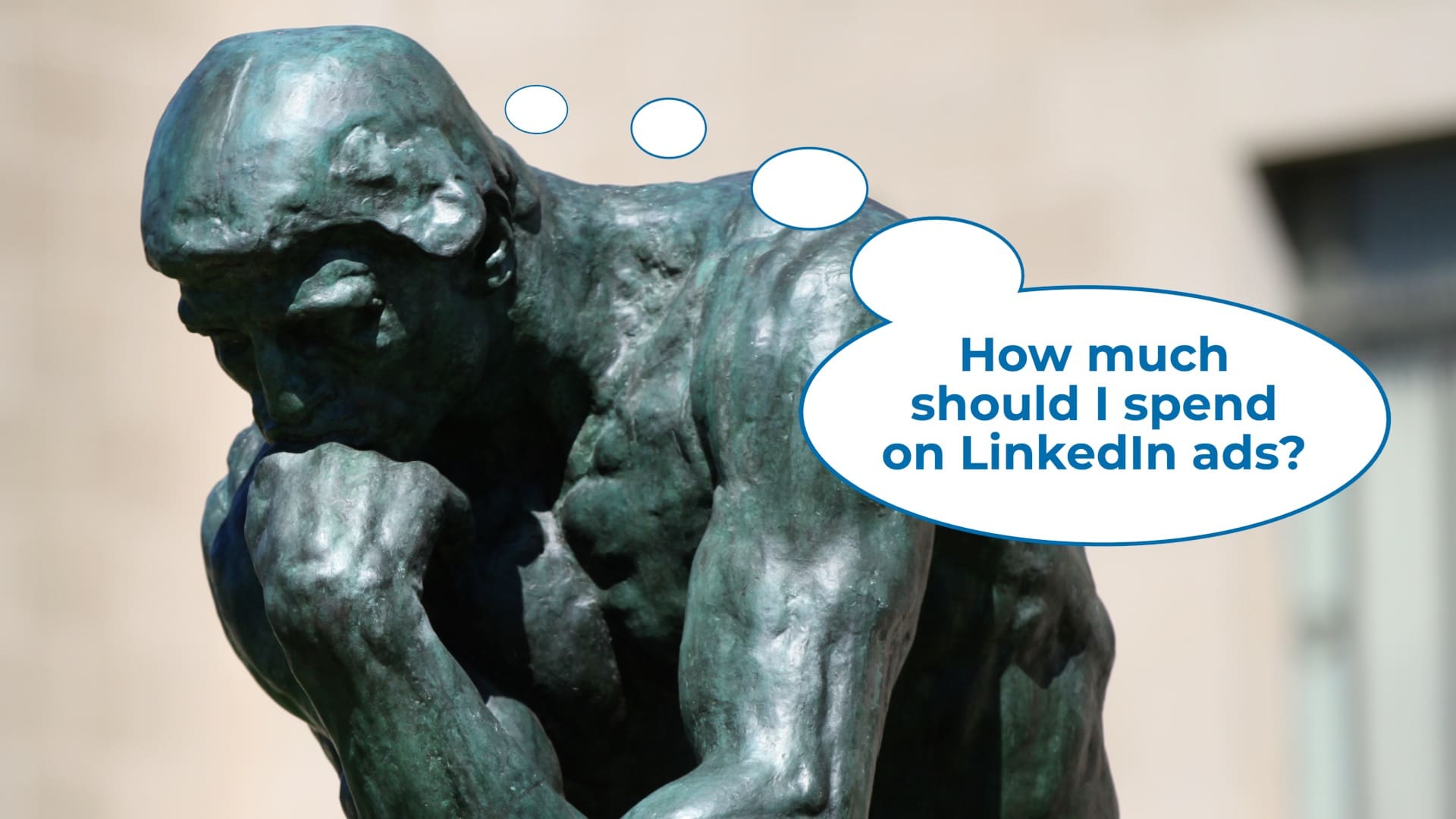
How Much Should I Spend On LinkedIn Ads?
